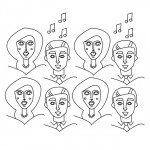
Yale New Haven Regular Singing, the University’s Sacred Harp singing ensemble, does not perform. Instead, its members sit in a hollow, democratic square, sopranos facing basses, tenors facing altos. Each singer is a listener, as well as a musician.
The group ranges from ten to twenty undergrads, graduate students, and New Haven community members. Founded about a year ago by Ian Quinn, a professor of music theory, the group chatters familiarly as they wait in the hall for a course section to vacate their meeting room in William L. Harkness Hall on Wall Street. Some are clearly regulars, and others, like me, are here for the first time.
In eighteenth-century New England, Puritans began Regular Singing to encourage the community to learn to read music and thereby renew religious devotion. The usual way had been to practice in unison a rote repertoire of only a handful of tunes each Sunday. These revivalists founded pedagogical singing schools, and around the turn of the nineteenth century, invented shape-note music notation. From do to do, each syllable had a shape. La, fa, and mi were transcribed to the page as tiny, stalked squares, triangles, and diamonds, nested between the black bars of the staff. To me, musical notes have been just dots on a page ever since I quit the trumpet in fourth grade. I can see how the shaped notes’ simple geometry would make sight-singing easier and, perhaps, religious devotion more accessible.
A proliferation of shape-note books appeared throughout New England in the early nineteenth century, the most famous of them called The Sacred Harp. Its title is now the common name for the practice of Regular Singing. After many iterations and editions, the book is still used today. I turn a copy over in my hands outside room 205 of Harkness Hall as I wait for the meeting to begin, fumbling with the wide, yellow pages.
Opening to a random page in The Sacred Harp, I find a song entitled “Save, Lord, or We Perish.” Below the strange-looking notes are the words from Luke: “Thy faith hath saved thee; go in peace.” Despite the message of faith, the group is secular. “We sing very religious music, without feeling like a religious group,” says Carson Evans ’13.
It is the music, not the meaning, that draws some people. Charles Biada ’13, a self-described agnostic-atheist and a member of the Yale Secular Student Alliance, has come almost every week since Quinn started the group. “If you’re going to sing old music and if you’re only going to sing songs that conform perfectly to your world view,” he says, “you’re going to find yourself with very few songs to sing. And all this old music—the poetry, the melodies, the ideas—is way too good not to sing. It’s simple and raw and real and beautiful.”
He adds, however, “If you as a singer did wish to treat the songs as a form of prayer at the individual level, the atmosphere could be conducive to that as well. So it’s not exactly religious, but it’s not un-religious either.”
Quinn calls everyone to order, joking with them and ushering me into a seat in the square arrangement of chairs. When the singing starts, we first sing tunes once through “on the notes,” with fa’s, so’s, and la’s, and then repeat them, adding lyrics. The music is alternately fast-paced and slow-moving, and it is uncomfortably loud at climatic moments. Many singers, books propped open on their laps or held in front of their eyes, let their free hands rise and fall in time with the music, creating an undulating line of metronomes. The fading evening light catches rays of dust motes through the high mullioned windows that look out onto Cross Campus, where I imagine passers-by hear our lilting verses.
The practice of Sacred Harp, sprung from the revivalist fervor of the same congregants who might have rubbed elbows with Elihu Yale in the wooden pews of their spare church naves, eventually faded from the North during the Civil War era. Rural Baptists in Alabama picked up the tradition and preserved it by singing the music not for an audience, but for God and for one another. Since then, Sacred Harp has wound its way back to this university, which was founded in 1701 to renew strict theological study after Harvard grew too lax and too liberal for the taste of some New England Puritans.
Now, though, this narrow, vaulted room is hardly filled with religious fervor. The voices of music majors mingle with those of atheist ex-Jews and Divinity School students as they sing together from Sacred Harp books.
“I feel like a great deal of Yale activities are very achievement-based, which is fine—we achieve many great and beautiful things here,” Evans remarks. “But singing your heart out is a nice release.”
Here, the only requisite is singing loudly, though the group still manages to sound quite beautiful. Coming together to sing centuries-old hymns in overlapping, swelling harmonies makes me feel like I am sitting not in a classroom but in the crowded pews of a colonial church—a noteworthy achievement indeed.


